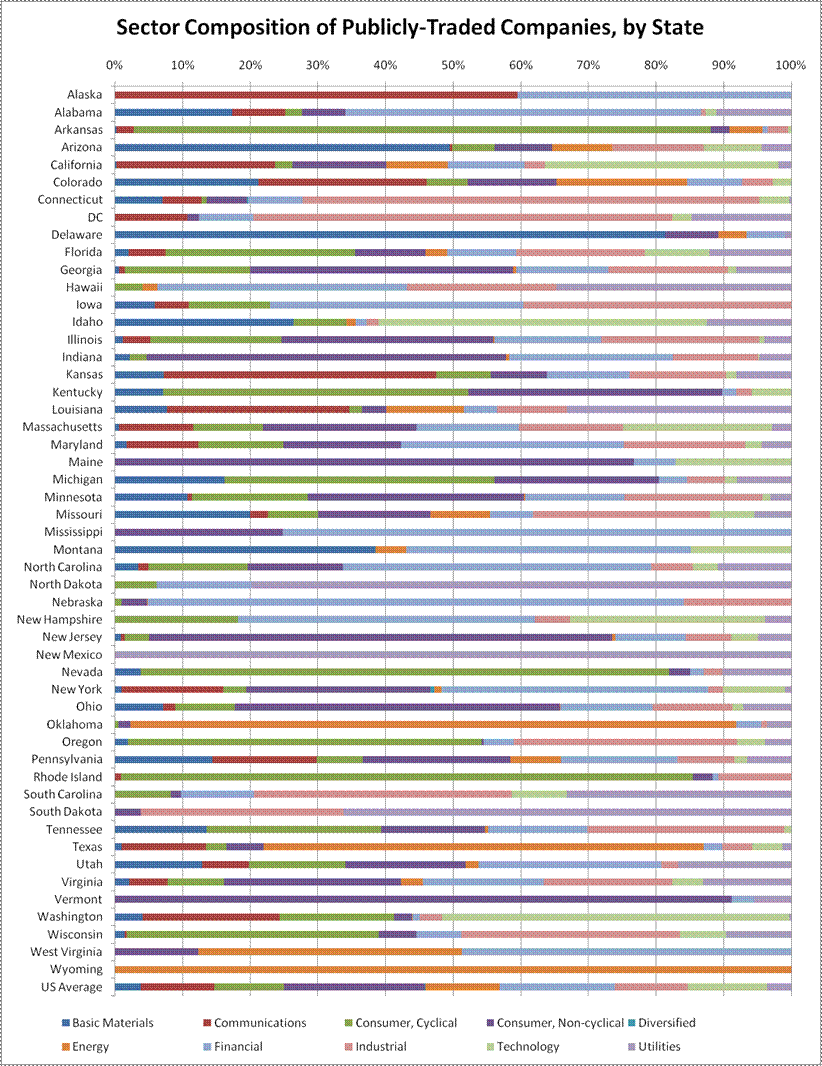For public companies in the US, what is the breakdown by state and then by sector, as measured by market capitalization:
Quite a graph.? Some states are like the US Average Sector mix, and some are very different. This set of two graphs will tell the story:
These are broad generalizations, but why are do some states have a set of publicly traded companies like or unlike the national average?
- Larger states tend to have larger cities, which nurture more diverse business ecosystems.
- States with notable educational institutions tend to produce more diverse business ecosystems.
- Some state cultures are more entrepreneurial, and tend to produce more diverse business ecosystems.
- Some states, because of the natural resources that they were endowed with, tend to have more companies in the area of the resources involved.? That seems to be especially true when it comes to the energy sector, which explains Wyoming, Oklahoma, and Texas.
- Much can be blamed on historical accident.? Why should Delaware have DuPont, except that that is where the founder lived and worked.
- Or, why should Nebraska be so big in financials?? Who could have expected 40 years ago that Warren Buffett’s Berkshire Hathaway would prosper so much, and that Warren would not move the business to a larger city?? But Buffett believed that it was an advantage to be away from Wall Street; it aids in independence of thought.
- That retailing marvel, Dillard’s Wal-Mart, is based in Bentonville, Arkansas, because the founder started it there.? Again, he could have moved, but the initial genius of Wal-Mart was focusing on under-served rural areas, without attracting competition from larger retailers.? Then when their purchasing power exceeded that of the legacy retailers, they competed against them directly in the major cities.
- To toss out one more, Green Mountain Coffee Roasters is based in Vermont, far from where coffee is grown, but that is where the company started, and the culture of the state that they initially served, Vermont,? helped shape the company that it became.
- The utility industry is space-limited, and is mostly regulated by the states, at least in terms of delivery to local clients.? Thus a state like New Mexico has PNM Resources, which mostly provides electricity and natural gas in New Mexico and Texas.? Similarly, North Dakota has MDU Resources which serves North Dakota, and parts of South Dakota, Wyoming and Montana.? Same for South Dakota, with Northwestern Corp, and Black Hills Corp.
- Then there are network effects, sometimes aided by regulation.? Nevada has the lion’s share of the gambling industry.? Regulation allowed for it, but once it got started, it became a destination for it, fixing it the minds of those that like to gamble.? Even as gambling regulations have declined in many states, it would be very difficult to dislodge Nevada’s first mover advantage.? The same logic applies to Wall Street, though New York State has a diverse economy.
Disclaimer and Summary
Now, remember the limitations here.? Private companies are equally important in the US, and so is the non-profit sector.? The reason that I work with the publicly traded companies, is that the data is readily available, and there is an easy summary statistic that is a proxy of the long-term value of the firm, equity market capitalization.? Maybe I should have used enterprise value, but I think that would have given undue weight to financials.
There are other ways to define value to society, each with its own set of flaws and data dirtiness problems.? This is just one simple way of trying to show the diversity of business in the US, segmented by sector and state.
One final note: I had to have a size cutoff in my study.? I used companies that had a market cap greater than $125 million on 2 September 2010.
More to come in Part 2.
UPDATE — Thanks to stevensaysyes for finding an error in my chart.? The corrected version is up now.? Mix up between the alphabetical order on state names versus address codes.



I think the N states got jumbled in the first chart. New York has a higher percentage of utilities than I imagine, and I don’t think North Dakota’s economy is quite so diverse.
Thanks, I will have a fixed version out in minutes.
Where is the source of your data?
Well done.
This reminded me of a recent study wherein the risk levels of fund managers themselves are a by product of the parts of the country in which they do business.
New York is home to risk laden Wall Street and is predominately a Catholic state, whereas the South and Midwest are generally more conservative and Protestant and I would assume have slight preponderance to having more risk averse managers such as at Legg Mason and T. Rowe Price. Recall the Protestant work ethic and deferral of gratification.
Catholics annually turned ports over 1.09% to only 0.79% for Protestants.
Recall the Protestant work ethic and deferral of gratification.
The geographic location of a fund is just as important as its investment strategies and can be significantly influenced by local religious beliefs.
http://papers.ssrn.com/sol3/papers.cfm?abstract_id=1523770
Here’s a corroborating chart:
http://en.wikipedia.org/wiki/File:Religions_by_State.PNG